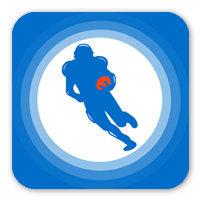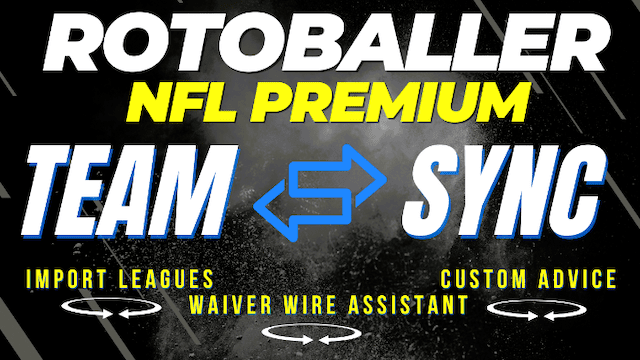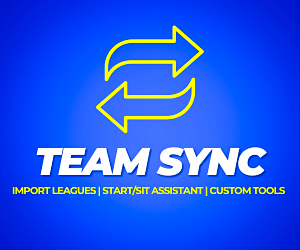Chris Gregory breaks down how to value fantasy football dynasty draft picks in trades or startup drafts, offering charts and different ways to evaluate picks.
This offseason, I convinced the powers that be at RotoBaller to approve a "Dynasty Primer" article series. Through these articles, I hope to address some big issues in fantasy football dynasty that go unanswered or underaddressed far too often. The biggest among these issues is how to properly value dynasty draft picks, which we will address today.
While countless “dynasty calculators” and “dynasty trade charts” exist, they are almost always tools that tell you what to do flat-out. Calculators don’t help you understand draft picks and their worth, nor do they help you make your own decisions. Rather, they make you pay for a flat answer based on their own specific player rankings. No context or foundation is given beyond their own numbers.
Here, we hope to do something different. Instead of just telling you what to do based on our own player values, we will try to analyze the inherent value of dynasty draft picks. In other words, we will attempt to build several fantasy versions of the NFL’s Draft Pick Value Chart. We hope to use data over the past decade to offer draft pick valuations that make sense to you and fit how you play fantasy.
Be sure to check all of our fantasy football rankings for 2025:- 2025 fantasy football rankings
- Running back (RB) rankings
- Wide receiver (WR) rankings
- Quarterback (QB) rankings
- Tight end (TE) rankings
- Defense (D/ST) rankings
- Kicker (K) rankings
- FLEX rankings
- Dynasty rankings
Note Before Reading: Tracking data for Superflex dynasty leagues is low, so the following charts/data use non-Superflex formats to get more reliable figures.
It All Starts With an Offer
Imagine this….
You have just begun your dynasty startup draft, non-Superflex with PPR scoring. Your inaugural selection was Puka Nacua at pick 1.09, and now you’re back on the clock at 2.04. The problem is you’re now torn over what to do with this second pick. There are two players you like equally sitting in your queue. Do you take the stud rookie Marvin Harrison Jr. or grab an elite RB in Jahmyr Gibbs?
Just as you are about to flip a coin and let fate decide, you get an alert on your phone. There’s a message in your inbox. Someone has sent you the following trade offer for your current pick….
| You Receive | Team B Receives |
| Pick 5.01 | Pick 2.04 |
| Team B’s 2025 1st round pick | Your 2025 3rd round pick |
If you’re like most people, you don’t quite know how a future draft pick should be valued in a deal like this.
You know that swapping your 2.04 for 5.01 effectively means you’re giving up Gibbs or Harrison Jr. and getting Zay Flowers instead. You also know that’s a drop you don’t love. Does a 2025 first-round rookie pick make that dip worth it?
To try and answer that question, we will start with a chart that I call the “ASPV Model.”
Using ADP to Evaluate Draft Picks (the ASPV Model)
Occam’s Razor states, “The simplest answer is often the best one.” When it comes to dynasty draft picks, the simplest answer is often average draft position (ADP herein).
Using ADP to value rookie-draft picks is simple. You just take the pick in question (let’s say pick 1.01 in rookie-only drafts). You then consider what player is being taken with 1.01 on average in rookie-only drafts. Then, you compare where that same player is being taken in dynasty startup drafts.
You’re simply comparing ADP in one type of draft (rookie-only) against another type (startup). It’s that easy.
For example, Bijan Robinson was last year's unanimous top rookie in non-Superflex drafts. His ADP was first overall (1.01) in rookie-only drafts, while his ADP in startups was fourth overall (1.04). Thus, having 1.01 in rookie drafts was equivalent to having 1.04 in startups last year. In other words, getting the top rookie equated to having the fourth-most coveted player in all non-Superflex dynasties.
Simple, right?
I call this basic ADP-based strategy the Average Startup Pick Valuation Model (ASPV).
To flesh this concept out, I collected rookie ADP data from multiple fantasy providers over the past 11 years (2013-2023). I then used those ADPs to get an average ASPV for each rookie draft pick over the past decade. Those values are as follows….
Final ASPV Model
| Non-Superflex Rookie-Draft Pick | Startup Draft Value |
| 1.01 | Pick No. 18 |
| 1.02 | Pick No. 29 |
| 1.03 | Pick No. 37 |
| 1.04 | Pick No. 40 |
| 1.05 | Pick No. 52 |
| 1.06 | Pick No. 57 |
| 1.07 | Pick No. 62 |
| 1.08 | Pick No. 84 |
| 1.09 | Pick No. 87 |
| 1.10 | Pick No. 88 |
| 1.11 | Pick No. 107 |
| 1.12 | Pick No. 108 |
| 2.01 | Pick No. 118 |
| 2.02 | Pick No. 125 |
| 2.03 | Pick No. 129 |
| 2.04 | Pick No. 125 |
| 2.05 | Pick No. 142 |
| 2.06 | Pick No. 162 |
| 2.07 | Pick No. 156 |
| 2.08 | Pick No. 158 |
| 2.09 | Pick No. 167 |
| 2.10 | Pick No. 177 |
| 2.11 | Pick No. 203 |
| 2.12 | Pick No. 205 |
| Picks 25-30 (Top-Half Round 3) | Pick No. 214 (Range: 174-246) |
| Picks 31-36 (Bottom-Half Round 3) | Pick No. 254 (Range: 189-301) |
| Round 4 Picks | Pick No. 346 (Range: 248-455) |
Interpreting the ASPV Data
There are a few things we can take from ASPV’s data.
First, the ASPV Model is based on average values over 11 years. When elite rookies like Saquon Barkley and Bijan Robinson come out, they are going to be drafted higher than usual in startups and the value of 1.01 will go up. In years where Josh Jacobs or Clyde Edwards-Helaire is the top rookie, 1.01’s value went down. ASPV offers an average ADP that considers these fluctuations.
The second thing worth noting is that the ASPV Model doesn’t consider success rate. It only measures the perceived value of draft picks. ASPV only cares about where the average dynasty manager is drafting these rookies. It does not measure whether most fantasy managers are right in these valuations or if the players actually produced.
A third thing worth noting is that ASPV is not intended to be a predictive tool. It is meant to offer draft pick value based on ADP only. However, ASPV has lent itself to predictivity more often than not, especially with early picks. For example, Dalton Kincaid’s startup ADP was 80th overall and ASPV valued his average rookie-only draft slot at 84th.
The final thing worth noting is ASPV's deviation spike in later rounds. In the earlier rounds, you will typically see rookies drafted in the same order, both in startups and rookie-only drafts. However, in later rounds you will see more fluctuation. This is not surprising, given that many fans/managers have less information on later-round picks. Thus, they are more apt to target needs over specific players in those situations.
Applying the ASPV Model to Our Draft Hypothetical
Considering ASPV's strengths and limitations, let's apply it to the hypothetical trade we gave you at the beginning of this column.
| You Receive | Team B Receives |
| 49th overall | 16th overall |
| Team B’s 2025 1st round pick | Your 2025 3rd round pick |
The best-case scenario for this trade is that Team B finishes last, and you win your championship in 2024. Unfortunately, those odds aren’t great. With this trade, Team B would have four of the top-25 picks in your startup draft, while you will face 2024 without your second-round pick. With that in mind, here is the likely return if you accept this trade….
| You Receive | Team B Receives |
| 49th Pick in 2024 | 16th Pick in 2024 |
| 1.09 in 2025 (ASPV: 87th) | 3.04 in 2025 (ASPV: 214th) |
This is a fine example of how ASPV can bring future picks into perspective. You are in a startup draft. ASPV translates future draft picks into startup draft picks. It’s basically Google Translate for dynasty… but better!
As for this trade offer, ASPV tells you that Team B wants you to give him pick No. 16 today and the 214th-ranked player in 2025. He is offering you the 49th pick in 2024 and the 87th-ranked player in 2025. Or, in simpler terms, he’s basically offering picks No. 49 and No. 87 for picks No. 16 and No. 214.
In those terms, would you accept Team B’s offer? Or do you want to see these values in terms of real players first?
One way to get even more perspective with ASPV is to use current ADP to assign real players to these ASPV values. Let's try that using Sleeper's current dynasty startup ADPs for 2024….
| You Receive | Team B Receives |
| Zay Flowers | Jahmyr Gibbs |
| Jayden Daniels
(aka future 1.09) |
Bo Nix
(aka future 3.04) |
This is the clearest context ASPV can provide. You are basically giving up Gibbs today and a Bo Nix-like player in 2025. You are getting Flowers now and a Jayden Daniels-like player (non-Superflex) in 2025.
Do you accept? Or do you still need more information to decide?
If you’re still undecided or ASPV doesn't scratch your itch, you're not alone. ASPV is just one tool to consider when evaluating dynasty draft pick trades. It doesn’t answer or address every significant dynasty factor you could want, such as the success rate of these picks. That is why I developed a companion model to go along with ASPV.
That model is something we will get into right… about… now!
Using a Success Based Model (SBM)
The Success Based Model (SBM herein) is simple in concept but difficult to execute. At its base, it helps determine how productive each rookie-only draft pick has been over the past 11 years. To execute it, I needed to collect a lot of data and determine parameters of what a successful or unsuccessful draft pick actually is.
To execute the SBM, I collected statics for every season of every fantasy-relevant player drafted since 2013. I then determined where each of these players was drafted in their dynasty rookie-only drafts. Finally, I had to craft categories that defined which player/picks were revelations, which were successes, and which were failures.
Here are the categories I ended up using for the SBM….
Home Run (HR): a “home run” player is…
- Any position player who finished top five at his position in at least two seasons (PPR);
- Any RB or WR who finished top 12 at his position in at least three seasons;
- Any QB or TE who finished top three at his position in at least three seasons; or
- Any player drafted between 2021-2023 who has at least one top-five finish at his position and is top-10 at his position in consensus 2024 redraft rankings.
Hit: a “hit” player is…
- Any RB or WR who finished top 36 at his position in three or more seasons (PPR);
- Any QB or TE who finished top eight at his position in three or more seasons; or
- Any player drafted after 2021 with one season of QB1, RB2, WR2, or TE1 production.
Miss: a “miss” player is…
- Any player drafted before 2020 who has failed to register a QB2, TE2, WR5, or RB4 season to date.
- Any player drafted between 2020-2022 who has failed to register a QB2, TE2, WR5, or RB4 season and is currently retired, not rostered, or is a backup with no positive buzz surrounding him (the 49ers’ Danny Gray, for example).
With those categories spelled out, let’s look at how often each rookie draft pick has produced which caliber of player over the past 11 years….
| Rookie Draft Pick | HR | Hit | Miss |
| 1.01 | 40% | 40% | 20% |
| 1.02 | 30% | 50% | 20% |
| 1.03 | 10% | 40% | 40% |
| 1.04 | 10% | 40% | 40% |
| 1.05 | 10% | 30% | 50% |
| 1.06 | 20% | 30% | 40% |
| 1.07-1.12 | 17% | 32% | 51% |
| 2.01-2.06 | 11% | 20% | 69% |
| 2.07-2.12 | 9% | 9% | 78% |
| 3.01-3.06 | 5.5% | 9.5% | 85% |
| 3.07-3.12 | 4.5% | 7.7% | 87.8% |
| 4th Round | 1.8% | 3.7% | 94.5% |
Analyzing the SBM Data
The first thing to note about the SBM chart is that some players were purposefully excluded from the data. While we are comfortable labeling players like Gibbs or C.J. Stroud as hits already, we cannot in good conscience label players like Bryce Young a “miss” simply because they struggled with a bad team in their first season. For this reason, we have tailored our failure figures to exclude such players.
Another thing worth noting is the first-round success rates of rookies over the past 11 years. To the surprise of absolutely no one, the top-two picks in rookie-only drafts (1.01 and 1.02) are significantly more valuable than any other pick. They have an 80% success rate and nearly double the chances of a home run. After those choices, the failure rate nearly doubles before leveling off and dipping again in the second round.
Perhaps the most surprising data point in SBM is how low the hit rate for rookie draft picks 1.03-1.12 is. A close analysis of the players taken with those picks shows little to no difference between the production of players picked at 1.03 and those chosen with 1.08. In fact, the HR rate and hit rates are actually lower for 1.03 and 1.04 than they are for 1.06 and 1.08.
Applying the Success Based Model
Earlier, we applied our ASPV Model to the hypothetical trade offer we laid out at the beginning of this article. Let’s now apply SBM to that same offer.
| You Receive | Team B Receives |
| 49th overall | 16th overall |
| A pick with a 45% miss rate | A pick with an 85% miss rate |
As stated earlier, the odds of Team B's draft pick becoming 1.01 or 1.02 are low. Team B began your startup with the first overall pick. After this trade, they would have four of the first 25 picks in the draft. With that start, odds favor Team B picking somewhere in the range of 1.07-1.12. Utter disaster would have to strike for Team B to have a top-two pick in 2025.
With that in mind, SBM says that rookie picks 1.03-1.12 generally have a 16% chance of becoming a home run player. Your odds of getting a hit are 39%, while your odds of missing are around 45%. If you actually end up with pick 1.09, as we projected earlier, then your likelihood of failure is approximately 40% and your odds of a home run are just 20%.
In this context, is the trade worth it? Is swapping Jahmyr Gibbs for Zay Flowers worth it if you get a pick with a 40-45% failure rate and just a 16-20% chance of becoming a star?
Depreciating Future Picks
The final factor we will consider today is the depreciation of future pick value.
When NFL teams execute trades, they follow the unwritten rule that future draft picks are worth less than current ones. This is for two reasons. One, GMs don’t know what those picks will be or what quality of players will be in the pool. Two, they need immediate returns on draft picks to keep their jobs or extend title windows. GMs don’t want to trade for assets that their replacement will use.
In other words, the pick in hand is worth two in that bush-like thing over there.
Dynasty managers share some of these concerns, at least when it comes to future draft picks. While ASPV and SBM might help alleviate that first concern about draft pick identity, it does nothing to solve the concern about longevity. Dynasty managers must always be cognizant that their league could fold with the exodus of just one or two members. This threat should always be factored into future pick value.
Unfortunately, no fantasy provider seems to track or offer data on the frequency of dynasty league deaths or how long leagues last. It appears to be a wholly circumstantial number that no one has any interest in tracking. Thus, there is no data or formula we can create to reach a flat future formula. All we can do is offer a few things that should always be considered before making a deal with futures.
- How Well Do You Know People in Your League?
This is perhaps the biggest key in devaluing future picks. If you are in a startup that you found on X or a social media post, be cautious.
If you personally know just one member of the league, or none, be cautious.
If you’ve never met anyone in your league in person, be cautious.
However, if you know everyone in your league and know they are devoted, then future picks hold more value. If you know the league will live, then you know you'll get to use those picks.
- How Does Your League Handle Dues?
Does your league pay two years in advance? If so, future picks are worth more.
Does our league require that you pay an extra year in advance if you trade away a future pick? If so, that future pick is worth more.
Does your league use a trustworthy site to hold payments, like LeagueSafe? Then, futures are worth more.
- How Old is Your League?
New leagues and startups fail often. Leagues that have lasted a decade are obviously more trustworthy. Thus, future picks are worth more in established leagues that have lasted more than five years with the same principal parties.
- What is Your Current Team Build?
When devaluing future draft picks, the final thing to consider is your team build. Even if you are in a solid league with plenty of settings to encourage longevity, future picks will hold different value for contenders and tankers.
If your team earned pick 1.03 or higher without suffering multiple major injuries, then you’re in a rebuild and veterans are worth less to you. Trade those vets for futures.
However, the converse is true for contenders.
If you finished as the high scorer in your league or won the title last year, then you are likely looking to compete in 2024. To you, trading picks in 2025 for veterans who fill roster holes may make the most sense.
Conclusion
After putting years of research and analysis into this issue, the sad truth is that there is no single answer for what dynasty draft picks are worth. No calculator can give you the right answer 100% of the time, nor will a case-by-case analysis. All you can do is try to consider the picks from all angles. That is why we have offered you several tools to address those angles.
The ASPV Model has its strengths and weaknesses. The biggest flaw is that it doesn't consider the success of future draft picks. ASPV’s biggest strength is that it gives you a finite draft pick value that is easy to understand, especially in the context of a startup draft. If you are trading startup pick No. 33 for a future first, it helps to understand that future first could be worth anywhere between picks No. 29-107.
Meanwhile, the SBM Model gives you an idea of how successful future draft picks are. This is also helpful when making deals for futures. If you are a borderline team deciding whether to rebuild or go all-in, it helps to know that trading Stefon Diggs for your league champ’s 2025 first would only offer you a 17% chance of a home run player and a 51% chance of failure.
Naturally, the best solution is to consider both models before making a deal. When you get an offer involving future picks, first consider what those picks are worth in ASPV. Then, use SBM to consider the success rate of those picks. Finally, consider how stable your league is and what your team is trying to do before finally hitting Deny or Accept.
Download Our Free News & Alerts Mobile App
Like what you see? Download our updated fantasy football app for iPhone and Android with 24x7 player news, injury alerts, rankings, starts/sits & more. All free!

More Fantasy Football Analysis





 RADIO
RADIO
























